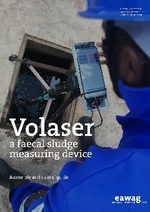Department Sanitation, Water and Solid Waste for Development
Volaser measuring device

Sustainable management of faecal sludge requires reasonable estimates of the quantities and qualities (Q&Q) that are accumulating at community to city-wide scale. In situ accumulation rates are difficult to determine as faecal sludge is often stored underground in containments, records frequently do not exist, and construction is not standardized, but estimates are necessary for planning scenarios as it represents the total amount of faecal sludge that needs to be managed. In the past, people have estimated accumulation based on literature values from other contexts, or educated guesses from users and emptying service providers, but these esitmates were not adequate to capture the desired accuracy and range of variability. To address the need for an affordable, accurate and easy to use device for measuring in situ volumes of faecal sludge, Eawag developed the Volaser (volume + laser) measuring device. The Volaser can be used to measure the volume of onsite sanitation containments and in situ volumes of faecal sludge. It consists of a tripod with distance-laser unit, a probe, and a smartphone application to operate the device. The smartphone is mounted on top of the tripod, the tripod is then set up over a vertical access port to the containment, and is lowered so that the laser-unit is fully inside the containment, but not immersed in the sludge. Then, the measurement is started in the app, and the top part is rotated manually while the laser measures the distance to the walls and the angle of rotation, in order to calculate the horizontal surface area of the containment. Afterwards, the distance from the top of the containment to the sludge surface and the GPS coordinates are also recorded. The depth of the containment is determined manually with a probe (approximately 300cm length). The volume of the sludge and of the containment can then be calculated.
The final version of the Volaser is comprised of 3D printed parts and components that can be obtained globally (either online and/or locally), and can be assembled by anyone, anywhere in the world. The assembly and operation manual will be available here soon.
More information on how to make estimations for Q&Q of faecal sludge at community to city-wide scales can be found here.
Collaborators
- Tribecraft AG
- JLS Digital
- Zürcher Hochschule der Künste (ZHdK)
- ETH Zürich
- SDC (funder)
- Eawag (funder)
Volaser - Assembly and operation manual
Volaser: A faecal sludge measuring device - Assembly and users’ guide. Andriessen, N. & Strande, L. (2023)
This manual provides step-by-step guidance on how to assemble and operate a Volaser device.
Smartphone application
The Volaser smartphone application can be downloaded from www.github.com/volaser .
Videos
Assembling a Volaser: https://www.youtube.com/watch?v=5vv_BZPrpHk
How to operate a Volaser: https://www.youtube.com/watch?v=GH2yi8qXduU
Publications
The Volaser: In Situ Measurements of Volumes of Faecal Sludge. Andriessen, N. & Strande, L. Sandec News, 2020



